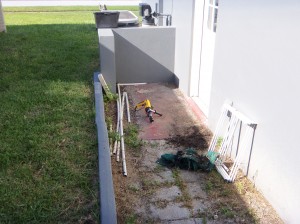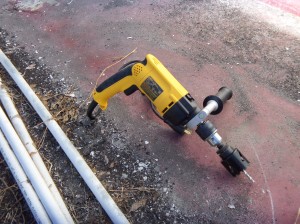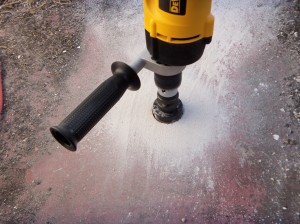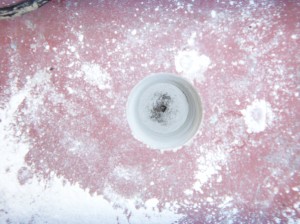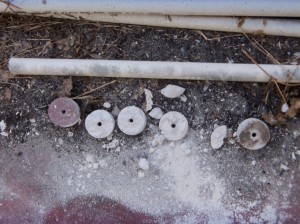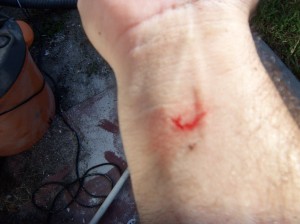Recently, The Girl and I enjoyed a typical POS Sunday. We spent quality time walking up and down the aisles of Home Depot, looking for ways to fix the existing problems at the house. Or ways to create new problems. Usually the latter.
On this particular trip we had a specific goal: put a hole in the concrete pad outside the back door of the garage.
No, not just for the fun of it. Our house is slightly downhill of the house next to us, which means that when it rains, the water runs toward our house. Making the problem even worse is that there is a retention wall surrounding the door. The retention wall keeps the soil from eroding away from the neighbor’s house, and keeps that soil from piling up against our door. Unfortunately, it makes a nice little area for the water to pool, and pool it does. The Girl and I have seen the water fill the area at least 8 inches high.
When the water fills that area, it has nowhere to flow, and eventually starts to leak into the garage. It runs through the garage and to the garage door. Because this has been happening for years, the garage door is rusting through at the bottom. That’s another project for another day.
So – back to Home Depot. We settled on a hole saw solution where we would drill through the pad, and then vacuum out the soil below the hole, and fill it with rocks, making a rough french drain solution. Unfortunately, the largest hole saw that we could find had a 2 inch diameter. I’m not convinced that this will be enough drainage, so we may have to widen the hole later, or add a second drain.
Oh man – here’s the best part. We’ve got a few drills. An impact driver, a standard drill, and ol’ busted drill. None are hammer drills. This project required a hammer drill. YES! So, The Girl and I walked out with a new drill bit, a drain cover, AND A NEW DRILL!
With the shopping out of the way, it was time to get down to serious business. I loaded up the new drill with the new drill bit, swept an area clean outside the door, and started to drill through the concrete. It was a slow process. It was hot outside. There was a lot of concrete dust. I would not be deterred.
The drilling took about thirty minutes, which was about twenty five minutes longer than I expected. The drill worked wonderfully though, but I would warn anyone using a hammer drill for the first time, it’s pretty intense.
Finally, there was a neat and tidy hole in the concrete, all the way through to the soil below. Next, I grabbed the shop vac (named Snuffaluffagus) and removed a bunch of the dirt under the pad. Then I put the drain cover on the hole, and voila! The only thing left to do was to test the drain.
And … I put the drain in the wrong place. The concrete pad actually seems to have a slight angle to it, meaning that the water pools in the corner, and I put the drain in the center. Which REALLY means that at some point in the near future I will need to repeat the process, hopefully with a 4 inch saw and drain this time to allow for higher drainage.
But, for now, mission accomplished!

